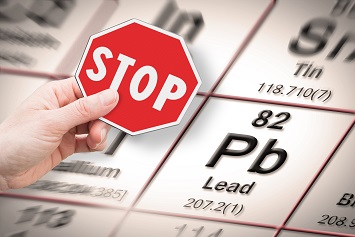On December 22, 2020, the EPA announced final revisions to the Lead and Copper Rule (LCR). These changes mark the first updates to this rule since it was created in 1991 to control lead and copper in drinking water.
The treatment technique for the LCR requires systems to monitor drinking water at customer taps, according to the EPA. “If lead concentrations exceed an action level of 15 ppb (parts per billion) or copper concentrations exceed an action level of 1.3 ppm (parts per million) in more than 10% of customer taps sampled, the system must undertake a number of additional actions to control corrosion. If the action level for lead is exceeded, the system must also inform the public about steps they should take to protect their health and may have to replace lead service lines under their control.”
Studies have shown that lead and copper primarily enter drinking water through plumbing materials, such as pipes. Health problems from lead and copper exposure range from stomach distress to brain damage. “In 2018, researchers estimated more than 400,000 deaths a year in the U.S. are linked to lead exposure,” according to the Chicago Tribune.
The final revisions, according to the EPA, include:
- “Using science-based testing protocols to find more sources of lead in drinking water.” “Based on better science, the new LCR requires water systems to follow new, improved tap sampling procedures that will better locate elevated levels of lead in drinking water,” according to the EPA Fact Sheet. “One key improvement in testing protocols is the new ‘fifth liter’ sampling requirement, which captures lead that can enter drinking water from a lead service line (LSL)—a lead pipe that connects tap-water service between a water main and house or building. Under the new rule, a sampler must draw four liters of water before collecting a test sample so that the water is more likely to come from the lead service line and not the internal plumbing of a building.”
- “Establishing a trigger level to jumpstart mitigation earlier and in more communities.” “The rule establishes a new threshold of 10 ppb, that when exceeded, requires more and rapid implementation of corrosion control treatment to reduce lead in drinking water,” the Fact Sheet notes. “The old rule allowed up to 48 months—four years—to pass in our small towns after a system exceeded the 15-ppb action level before corrosion control was in place. The new rule’s trigger level requires systems that already have corrosion control to re-optimize their treatment. It also requires systems that do not have corrosion control to conduct a corrosion control study to identify the best treatment approach. If that system exceeds the action level in the future, the system must install the treatment it identified in its study right away. The 10 ppb trigger level also requires systems to start lead service line replacement programs.”
- Drive more LSL replacements. “The old rule created so many loopholes that since 1991—over nearly 30 years—only 1 percent of utilities actually replaced lead pipes as a result of an action level exceedance,” says the Fact Sheet. “Under the new rule, water systems will be required to fully replace at least 3 percent of lead service lines each year when 10 percent of sampling results are above 15 ppb. The new rule’s real 3% replacement rate will do more to remove lead service lines than the old rule’s unmet 7 percent rate by propelling early action, closing loopholes, and strengthening replacement requirements.”
- Required testing in schools and childcare facilities. Water systems will be required to annually test drinking water in 20 percent of childcare centers and elementary schools for a period of 5 years. Such testing is to be provided upon request to secondary schools and will be provide upon request to daycare and elementary schools after the initial 5-year period. “Water systems must provide the results of these tests and information about the actions the school or childcare facility can take to reduce lead in drinking water,” according to Beveridge & Diamond P.C., a Washington, D.C.-based environmental law firm, in an article published in Lexology.
- “Requiring water systems to identify and make public the locations of lead service lines.” Identifying high-risk homes serviced with lead water lines is a major driver for the EPA. The final rule requires all water systems to “prepare, and update LSL inventories,” according to the Beveridge & Diamond Lexology article. “EPA also introduces a requirement to ‘find and fix’ sources of lead in any individual home where a test demonstrates lead levels in excess of 15 ppb. When the ‘fix’ is outside of the water system’s control, documentation must be provided to the state. The final rule further modifies tap sampling procedures and the criteria for selecting homes for sampling to prioritize homes served by LSLs.”
The EPA also states the final rule will achieve greater transparency by requiring water systems that service more than 50,000 people to post information about their LSL inventories on a website accessible to the public. The previous threshold was reduced from 100,000 people.
“In addition, the final rule mandates annual notices by water systems to homeowners with LSLs,” according to the Beveridge & Diamond article. “Certain systems that fail to reach their LSL replacement requirements for a given year must conduct additional outreach in the following year, such as through a townhall meeting. And when any individual tap sample exceeds the lead action level of 15 ppb, systems are now required to notify consumers at the site within 24 hours of learning of the result (instead of the current 30 days).”
“This new Lead and Copper Rule will protect children and families from exposure to lead in drinking water,” said EPA Administrator Andrew Wheeler in a press release. “For the first time in nearly thirty years, this action incorporates best practices and strengthens every aspect of the rule, including closing loopholes, accelerating the real world pace of lead service line replacement, and ensuring that lead pipes will be replaced in their entirety.”
The final rule retained the current lead “action level” of 15 ppb and “maximum contaminant level” goal of zero.
Not Enough
Critics believe the final rule does not reach far enough to correct the problems stemming from LSLs. When water is not used for a few hours in systems with LSLs, lead leaches into the lines. An additional problem with LSLs is that the lines can be “jostled,” releasing lead particles when street or water line repairs are made.
“Both the EPA and the Centers for Disease Control and Prevention concluded years ago there is no safe level of exposure to lead,” according to the Chicago Tribune.
“They nibbled around the edges but did not fundamentally fix the problem,” said Erik Olson, an attorney with the Natural Resources Defense Council who unsuccessfully sued for changes in federal regulations during the 1990s, in the Chicago Tribune. “That’s really disappointing and amounts to a missed opportunity.”
Case Studies
When high levels of lead-tainted water began flowing into households in Flint, Michigan, the city’s problems highlighted dire consequences when public water systems fail to maintain their water systems, according to the Chicago Tribune. See the CNN timeline for more information about the issues in Flint.
Many sources cite these updates to the LCR as a response to the Flint water crisis.
Several large U.S. cities previously installed LSLs to deliver drinking water to their residents until they were banned by Congress in 1986. As a result, significant old LSL pipes remain in service throughout the United States.
The Chicago Tribune reports that there are 400,000 LSLs connecting homes to Chicago water lines, with only 750 of those lines expected to be replaced in 2021.
“There still is no federal standard for the amount of lead allowable in tap water from individual homes,” the Chicago Tribune notes. “Even under the Trump EPA regulations, utilities are considered to be in compliance as long as 90% of the homes tested have lead levels below 15 (15 ppb), a standard that isn’t based on scientific evidence of dangers posed by the toxic metal.
“The new rules add another threshold that requires utilities to begin drafting plans for service line replacements if lead levels in 90% of homes sampled exceed 10 ppb,” according to the Chicago Tribune. “Utilities also will be required to provide results more promptly to homes that exceed the EPA’s new ‘trigger level.’”
Long-lasting cognitive problems in children have been documented by the American Academy of Pediatrics, with exposures to lead concentrations of just 5 ppb.
The previous requirement of collecting only 50 samples every 3 years in big cities like Chicago was also retained by the final rule.
“The Tribune reported in 2016 that most of the homes sampled in Chicago are owned by water department employees or retirees living on the Far Northwest and Far Southwest sides, where cases of lead poisoning are rare,” says the Chicago Tribune. “Only two of the federally required samples drawn in Chicago during 2018 exceeded the Trump EPA’s new threshold of 10 ppb, according to state records.
“By contrast, results from the city’s separate, free testing program show more than 10% of the 12,316 homes sampled last year had lead levels exceeding 10 ppb after running water for a couple of minutes,” the newspaper adds. “Lead-contaminated water has been found in at least one home in all 77 community areas since the water department began offering testing kits in 2016.”
While the main push by concerned groups to replace lead water lines was only met with a minimum of 3 percent replacement requirement at 15 ppb, some critics of the final rule have said it’s a step in the right direction.
Flint Mayor Sheldon Neeley said the rule was not “perfection, but it is progress,” according to Reuters.


